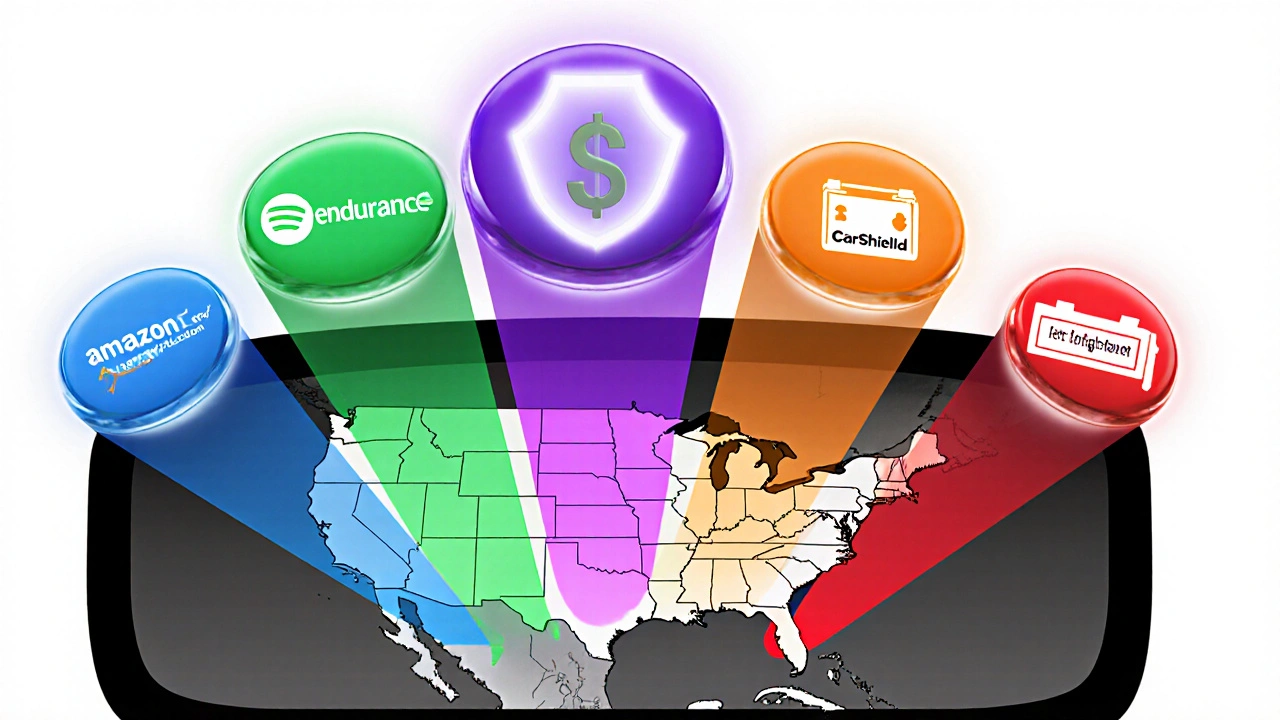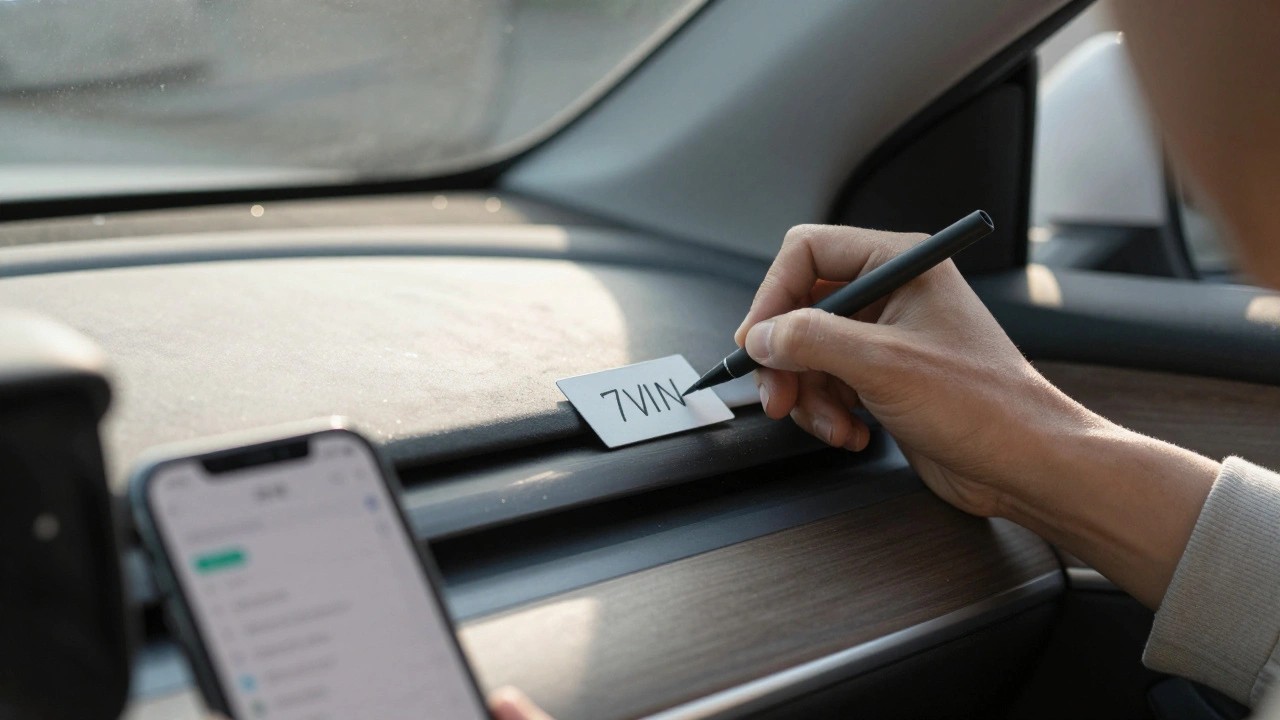When your new car’s factory warranty runs out, you’re left with a big question: do you pay for a third-party extended warranty? Many drivers assume these plans are just expensive add-ons. But the truth? A good third-party warranty can save you thousands if your transmission fails, your engine blows, or your electronics go haywire after 80,000 miles.
What Exactly Is a Third-Party Warranty?
A third-party warranty isn’t offered by the car manufacturer. It’s sold by a separate company-often an insurance provider or warranty administrator-that backs the repair costs after your factory coverage ends. These plans cover repairs for things like the engine, transmission, drivetrain, and sometimes even electrical systems or air conditioning.
Unlike factory warranties, which are tied to the brand and dealership network, third-party plans let you choose where to get repairs done. That means you’re not stuck going back to the same dealership that sold you the car. You can use any licensed mechanic in the U.S. That’s a big deal if you’ve moved, or if your local dealer has terrible service.
Why People Buy Third-Party Warranties
Most buyers don’t buy these plans because they want to. They buy them because they’re afraid of getting hit with a $4,000 repair bill after their factory warranty expires. Here’s what actually happens:
- Someone buys a used 2021 Honda Accord with 65,000 miles. Factory warranty ends at 60,000 miles or 5 years.
- At 72,000 miles, the transmission starts slipping. Repair cost: $3,800.
- If they had a third-party warranty for $1,200, they pay a $100 deductible and walk away with a working car.
That’s not a hypothetical. That’s a real case from a Detroit resident who posted about it on Reddit last month. His mechanic said the transmission was beyond repair without a rebuild-something most people can’t afford out of pocket.
Third-party warranties aren’t for everyone. But if you drive more than 12,000 miles a year, own a car with a history of expensive repairs, or plan to keep your vehicle past 100,000 miles, this isn’t a luxury-it’s insurance.
How Third-Party Warranties Work
It’s simpler than it sounds. You pay a one-time fee (or monthly installments) for a contract that lasts 2 to 7 years or up to a certain mileage cap-usually 100,000 to 150,000 miles. When something breaks:
- You take the car to a licensed repair shop.
- You call the warranty company to file a claim.
- They approve the repair and pay the shop directly.
- You pay the deductible-typically $50 to $150.
Some companies require pre-approval before you even start repairs. Others let you pay upfront and get reimbursed. The difference matters. If your car dies on the side of the road, you don’t want to wait 48 hours for approval.
Not all repairs are covered. Exclusions vary wildly. Common ones include:
- Wear-and-tear items (brakes, tires, wipers)
- Damage from poor maintenance (like not changing oil)
- Aftermarket modifications
- Accidental damage or flooding
Read the fine print. If the contract says “powertrain only,” you’re not covered for your infotainment screen or heated seats. That’s a trap many people fall into.

Top 5 Third-Party Warranty Providers in 2025
There are over 50 companies offering extended warranties. But only five consistently deliver on service, coverage, and customer satisfaction based on 2025 consumer reports and claims data.
| Provider | Best For | Coverage Length | Mileage Cap | Deductible | Repair Network | Customer Rating (out of 5) |
|---|---|---|---|---|---|---|
| Endurance | High-mileage vehicles | Up to 7 years | 200,000 miles | $99 | 20,000+ shops nationwide | 4.8 |
| CarShield | Budget buyers | Up to 5 years | 150,000 miles | $50-$100 | 15,000+ shops | 4.6 |
| ProtectMyCar | Electric and hybrid cars | Up to 6 years | 175,000 miles | $100 | 18,000+ shops | 4.7 |
| Amazon Auto Protection | Convenience seekers | Up to 5 years | 150,000 miles | $100 | 12,000+ shops | 4.5 |
| Liberty Bell Auto Protect | Older luxury vehicles | Up to 7 years | 180,000 miles | $150 | 16,000+ shops | 4.4 |
Endurance stands out because it covers over 5,000 components-including electronics, sensors, and even the infotainment system. Most competitors only cover the powertrain. CarShield is the cheapest, but its coverage is more limited. ProtectMyCar is the only one that explicitly covers EV battery degradation after 100,000 miles-a growing concern as more people keep electric cars past the factory warranty.
What’s Not Covered (And Why It Matters)
One person in Ohio paid $1,400 for a warranty that didn’t cover their car’s fuel pump. Why? Because the contract listed “fuel system components” as excluded. The pump cost $850 to replace. They had to pay out of pocket.
Exclusions are the #1 reason people regret buying a warranty. Here’s what most plans leave out:
- Pre-existing conditions (if your AC was already failing when you bought the plan)
- Fluid leaks unless they cause major damage
- Software updates or glitches in newer vehicles
- Body panels, paint, or interior wear
- Damage from using the wrong oil or coolant
Some companies use vague language like “mechanical breakdown” without defining it. That’s a red flag. Ask for a full list of covered and excluded parts in writing. If they won’t give it to you, walk away.
Real Reviews: What Owners Actually Say
Look at Reddit threads, Trustpilot, and BBB reviews. Real people aren’t lying. Here’s what they’re saying in 2025:
- Endurance: “My 2019 Toyota RAV4’s transmission went out at 98,000 miles. They paid $3,200. Took three days. No hassle.”
- CarShield: “They denied my claim because they said I didn’t change the oil on time. I had receipts. They still refused. Never again.”
- ProtectMyCar: “My 2022 Chevy Bolt’s battery dropped to 72% capacity. They covered the replacement. No questions asked.”
- Amazon Auto Protection: “Easy to buy online. Took 10 minutes. But when my starter failed, they made me wait 11 days for approval.”
- Liberty Bell: “Worth it for my 2017 BMW X5. Covered the timing chain, water pump, and valve cover gasket-all $4,000 in repairs.”
Patterns emerge. The best companies respond fast, pay directly, and have clear rules. The worst ones nitpick maintenance records, delay approvals, and use technicalities to deny claims.

How to Pick the Right Plan
Here’s a simple decision tree:
- Is your car a known problem model? (e.g., Ford EcoBoost engines, GM transmissions, Toyota hybrid inverters) → Buy a warranty.
- Do you drive over 15,000 miles a year? → Buy a warranty.
- Are you keeping the car past 100,000 miles? → Buy a warranty.
- Can you afford a $3,000-$5,000 repair if something breaks? → Don’t buy one.
If you answered yes to any of the first three, a third-party warranty is smart. If you answered yes to the last one, you might not need it.
Also, buy it before your factory warranty expires. Most companies won’t cover cars with over 100,000 miles or older than 10 years. Some won’t cover anything over 80,000 miles. Time matters.
What to Avoid
Here are the top three scams in 2025:
- “Lifetime” warranties: These are marketing gimmicks. They often cap coverage at 100,000 miles or stop paying after 5 years.
- Dealership add-ons: Dealers mark up third-party warranties by 200-300%. You can buy the same plan online for half the price.
- Zero-deductible plans: They’re usually more expensive and come with tighter restrictions. Paying $100 upfront is worth it for broader coverage.
Don’t buy from a company that doesn’t have an A- rating from the BBB or a 4.0+ average on Trustpilot. If they’re not transparent about their underwriter (the insurance company backing the plan), walk away.
Final Advice
Third-party warranties aren’t magic. They’re insurance. You pay now to avoid disaster later. The best plans don’t promise to cover everything-they promise to cover the things that will break and cost you the most.
Compare at least three providers. Read 10 real reviews. Ask for the full contract. Don’t let sales pressure push you into a plan that doesn’t fit your car or your budget. If you drive a lot, keep your car long, and don’t want to gamble on a $4,000 repair, a good third-party warranty isn’t a waste. It’s peace of mind.
Are third-party warranties worth it?
Yes-if your car is prone to expensive repairs, you drive a lot, or you plan to keep it past 100,000 miles. They’re not worth it if you can afford to pay for major repairs out of pocket or if your car is reliable and low-mileage.
Can I use any mechanic with a third-party warranty?
Most plans let you use any licensed mechanic in the U.S., but you must notify the warranty company before repairs. Some require pre-approval. Always confirm your provider’s rules before showing up at a shop.
Do third-party warranties cover electric vehicles?
Only a few do. ProtectMyCar and Endurance are the only major providers that explicitly cover EV battery degradation and charging system failures. Most standard plans exclude EV-specific components.
Can I cancel a third-party warranty and get a refund?
Yes, most offer a prorated refund if you cancel early, but you’ll lose the first 30-60 days of coverage. Some charge a cancellation fee. Always check the refund policy before signing.
How much does a third-party warranty cost?
Prices range from $800 to $2,500 depending on the car, coverage level, and term. Luxury and high-mileage vehicles cost more. Monthly payment plans are common, but paying upfront usually saves 10-15%.






Jeanie Watson
November 17, 2025 AT 23:20I just got a CarShield plan last year and honestly? Best $800 I ever spent. Transmission went out at 92k, they paid everything minus the $75 deductible. No drama, no games.
Tom Mikota
November 19, 2025 AT 14:38Let’s be real-third-party warranties are just a fancy way of saying ‘pay extra so some middleman can deny your claim with a 47-page PDF full of tiny print.’ I’ve seen it too many times: ‘You didn’t change your oil on day 12,000.3’-like, bro, it’s a car, not a space shuttle.
And why does every single one of these companies use ‘up to 7 years’ as their marketing hook? That’s not a warranty, that’s a lottery ticket.
Also, ‘20,000+ shops’? Cool. But which ones? Can I take it to the guy who fixes my neighbor’s Honda out of his garage? No? Then it’s not really a network, it’s a fantasy.
And don’t get me started on ‘lifetime’ warranties. If your warranty outlives your car, congrats-you won the scam lottery.
Bottom line: if you can’t afford a $3k repair, don’t buy a car that costs $3k to fix. Simple.
Mark Tipton
November 20, 2025 AT 08:36There is a critical flaw in the entire premise of this article: it assumes that mechanical failure is random and unpredictable. It is not. The vast majority of catastrophic failures-transmissions, engines, EV batteries-are preceded by subtle, measurable degradation patterns over time. If you are not monitoring your vehicle’s diagnostic data via OBD-II logs, tracking fluid temperatures, or analyzing torque converter lock-up cycles, you are not being proactive-you are being negligent.
Furthermore, the notion that third-party warranties are ‘insurance’ is a misnomer. Insurance pools risk across millions. These are service contracts with underwriters who are legally permitted to deny claims based on ‘pre-existing conditions’ defined in the fine print-which, by the way, are often retroactively applied after a failure occurs.
Real insurance doesn’t require you to submit 14 forms, 7 receipts, and a notarized affidavit that you didn’t ‘modify’ your air intake with a K&N filter. Yet here we are.
And let’s not ignore the elephant in the room: the entire industry is structured to maximize customer acquisition and minimize payout. The profit margin on these contracts is 68–82%. That’s not a service. That’s a financial product disguised as protection.
If you truly want to avoid repair shock, invest in a $300 OBD2 scanner, a $50 subscription to Carfax, and a $100/month sinking fund. You’ll end up ahead and actually understand your car.
Also, ProtectMyCar covers EV battery degradation? Only if the degradation is below 20% and not caused by ‘non-OEM charging equipment.’ Which, of course, is defined as ‘any charger not sold by GM, Ford, or Tesla.’ So… it’s covered unless it’s actually useful.
Adithya M
November 22, 2025 AT 08:12Bro, this is why you need to check reviews on Reddit and Trustpilot before buying. I bought Endurance for my 2018 Camry, and they paid for my head gasket at 112k miles. No issues. But my cousin got CarShield-he had a leaky radiator and they said it was ‘wear and tear.’ He had maintenance records. They still denied. Don’t trust the ads. Trust real people.
Jessica McGirt
November 23, 2025 AT 14:46I appreciate the thorough breakdown, especially the emphasis on reading the fine print. One thing I’d add: always ask for a written list of covered components before signing. If they hesitate or say ‘it’s all in the contract,’ that’s a red flag. A reputable company will gladly send you a PDF. Also, check if the warranty is transferable-if you sell the car later, it can add value. I transferred mine when I sold my Accord, and the buyer was thrilled.
Donald Sullivan
November 23, 2025 AT 22:31Dealerships are the worst. They push these warranties like they’re giving you free money. I bought one through my dealer for $2,200. Found the exact same plan online for $900. They literally just added their logo. Don’t be that guy.
Tina van Schelt
November 23, 2025 AT 22:31Warranties are like emotional support blankets for your car. You don’t *need* it, but when that transmission starts whining at 3 a.m., you’ll be crying tears of gratitude that you bought it. I kept my 2015 Accord past 150k miles thanks to Endurance. That $1,100 felt like a spa day for my wallet.
Ronak Khandelwal
November 24, 2025 AT 22:03Love this thread! 🙌 Real talk: owning a car past 100k isn’t about luck-it’s about mindset. Warranties aren’t just about money, they’re about peace. And peace? Priceless. 🌿 If you’re keeping your car, you’re already winning. Just make sure your warranty doesn’t come with hidden traps. Read. Ask. Compare. You got this! 💪
Jeff Napier
November 24, 2025 AT 22:52Who’s behind these warranty companies? Hint: not your mechanic. It’s the same conglomerates that own your credit card company and your insurance provider. They want you to think you’re protected. You’re not. You’re just feeding the machine. They profit when you pay. They profit when you don’t claim. They profit when you’re confused. Always question who’s really winning.
Sibusiso Ernest Masilela
November 26, 2025 AT 15:28How quaint. You people actually believe these corporate fairy tales? You pay for a ‘warranty’ and then beg for scraps while some faceless underwriter in Nebraska decides whether your $3,000 repair is ‘mechanical breakdown’ or ‘neglect.’ Meanwhile, the dealer who sold you the car made $15,000 profit. You’re not buying protection-you’re buying a one-way ticket to financial humiliation. Classy.
Daniel Kennedy
November 28, 2025 AT 10:41Just wanted to say thanks to everyone sharing real experiences. This is exactly the kind of honest talk that helps people avoid getting screwed. One thing I’ve learned: if the warranty company doesn’t have a direct pay network (they pay the shop, not you), walk away. Reimbursement is a nightmare when your car’s dead and you’re stuck with a $3k bill. Endurance and ProtectMyCar do direct pay. That’s the gold standard.
Taylor Hayes
November 30, 2025 AT 10:05Reading all this, I feel like I’ve been here before. I bought a warranty for my 2016 Accord, and honestly? It saved me when the fuel pump died. But I also learned: never buy from a company that doesn’t let you call them directly. Some of these places make you go through a third-party claims portal. If you’re stuck on hold for 45 minutes while your car sits in a parking lot, you’re not protected-you’re just trapped.
My advice? Call the company yourself before you buy. Ask a simple question. See how they respond. That’s your real test.
Sanjay Mittal
December 2, 2025 AT 00:02For anyone considering ProtectMyCar for an EV: their battery coverage is legit. My 2021 Nissan Leaf’s capacity dropped to 76% at 115k miles. They replaced the pack. Took 10 days. No hassle. Only EV warranty that actually covers degradation, not just ‘failure.’